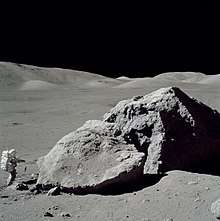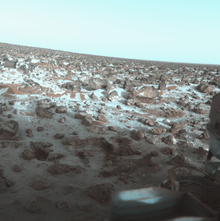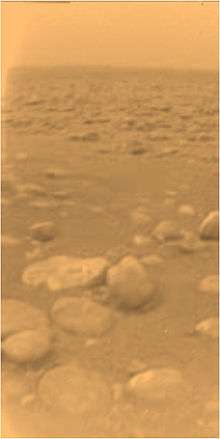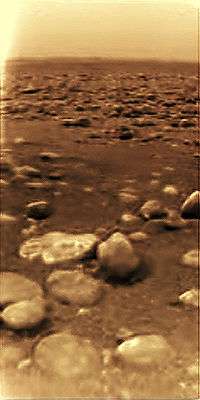Planetary geology


Planetary geology, alternatively known as astrogeology or exogeology, is a planetary science discipline concerned with the geology of the celestial bodies such as the planets and their moons, asteroids, comets, and meteorites.[1][2] Although the geo- prefix typically indicates topics of or relating to the Earth, planetary geology is named as such for historical and convenience reasons; applying geological science to other planetary bodies. Due to the types of investigations involved, it is also closely linked with Earth-based geology.
Planetary geology includes such topics as determining the internal structure of the terrestrial planets, and also looks at planetary volcanism and surface processes such as impact craters, fluvial and aeolian processes. The structures of the giant planets and their moons are also examined, as is the make-up of the minor bodies of the Solar System, such as asteroids, the Kuiper Belt, and comets.
History of planetary geology
Eugene Shoemaker is credited with bringing geologic principles to planetary mapping and creating the branch of planetary science in the early 1960s, the Astrogeology Research Program, within the United States Geological Survey. He made important contributions to the field and the study of impact craters, Selenography (study of the Moon), asteroids, and comets.[3]
Today many institutions are concerned with the study and communication of planetary sciences and planetary geology. The Visitor Center at Barringer Meteor Crater near Winslow, Arizona includes a Museum of planetary geology. The Geological Society of America's Planetary Geology Division has been growing and thriving since May 1981 and has two mottos: "One planet just isn't enough!" and "“The GSA Division with the biggest field area!"
Major centers for planetary science research include the Lunar and Planetary Institute, the Applied Physics Laboratory, the Planetary Science Institute, the Jet Propulsion Laboratory, Southwest Research Institute, and Johnson Space Center. Additionally, several universities conduct extensive planetary science research, including Montana State University, Brown University, the University of Arizona, Caltech, the University of Colorado, Western Michigan University, MIT, and Washington University in St. Louis.
Features and terms
Planetary geology uses a wide variety of standardised descriptor names for features.[4] All planetary feature names recognised by the International Astronomical Union combine one of these names with a possibly unique identifying name. The conventions which decide the more precise name are dependent on which planetary body the feature is on, but the standard descriptors are in general common to all astronomical planetary bodies. Some names have a long history of historical usage, but new must be recognised by the IAU Working Group for Planetary System Nomenclature as features are mapped and described by new planetary missions.[5] This means that in some cases names may change as new imagery becomes available,[5] or in other cases widely adopted informal names changed in line with the rules.[6] The standard names are chosen to consciously avoid interpreting the underlying cause of the feature, but rather to describe only its appearance.[4]
| Feature | Pronunciation[7] | Description | Designation |
|---|---|---|---|
| Albedo feature | /ælˈbiːdoʊ/ | An area which shows a contrast in brightness or darkness (albedo) with adjacent areas. This term is implicit. | AL |
| Arcus, arcūs | /ˈɑːrkəs/ | Arc: curved feature | AR |
| Astrum, astra | /ˈæstrəm/, /ˈæstrə/ | Radial-patterned features on Venus | AS |
| Catena, catenae | /kəˈtiːnə/, /kəˈtiːni/ | A chain of craters e.g. Enki Catena. | CA |
| Cavus, cavi | /ˈkeɪvəs/, /ˈkeɪvaɪ/ | Hollows, irregular steep-sided depressions usually in arrays or clusters | CB |
| Chaos | /ˈkeɪɒs/ | A distinctive area of broken or jumbled terrain e.g. Iani Chaos. | CH |
| Chasma, chasmata | /ˈkæzmə/, /ˈkæzmətə/ | Deep, elongated, steep-sided depression e.g. Eos Chasma. | CM |
| Colles | /ˈkɒliːz/ | A collection of small hills or knobs. | CO |
| Corona, coronae | /kɒˈroʊnə/, /kɒˈroʊni/ | An oval feature. Used only on Venus and Miranda. | CR |
| Crater, craters | /ˈkreɪtər/ | A circular depression likely created by impact event. This term is implicit. | AA |
| Dorsum, dorsa | /ˈdɔːrsəm/, /ˈdɔːrsə/ | Ridge, sometimes called a wrinkle ridge e.g. Dorsum Buckland. | DO |
| Eruptive center | An active volcano on Io. This term is implicit. | ER | |
| Facula, faculae | /ˈfækjʊlə/, /ˈfækjʊli/ | Bright spot | FA |
| Farrum, farra | /ˈfærəm/, /ˈfærə/ | Pancake-like structure, or a row of such structures. Used only on Venus. | FR |
| Flexus, flexūs | /ˈflɛksəs/ | Very low curvilinear ridge with a scalloped pattern | FE |
| Fluctus, fluctūs | /ˈflʌktəs/ | Terrain covered by outflow of liquid. Used on Venus, Io and Titan. | FL |
| Flumen, flumina | /ˈfluːmɪn/, /ˈfluːmɪnə/ | Channel on Titan that might carry liquid | FM |
| Fossa, fossae | /ˈfɒsə/, /ˈfɒsi/ | Long, narrow, shallow depression | FO |
| Fretum, freta | /ˈfriːtəm/, /ˈfriːtə/ | Strait of liquid connecting two larger areas of liquid. Used only on Titan. | FT |
| Insula, insulae | /ˈɪnsjuːlə/, /ˈɪnsjuːli/ | Island (islands), an isolated land area (or group of such areas) surrounded by, or nearly surrounded by, a liquid area (sea or lake). Used only on Titan. | IN |
| Labes, labes | /ˈleɪbiːz/ | Landslide debris. Used only on Mars. | LA |
| Labyrinthus, labyrinthi | /læbɪˈrɪnθəs/, /læbɪˈrɪnθaɪ/ | Complex of intersecting valleys or ridges. | LB |
| Lacuna, lacunae | /ləˈkjuːnə/, /ləˈkjuːni/ | Irregularly shaped depression having the appearance of a dry lake bed. Used only on Titan. | LU |
| Lacus, lacūs | /ˈleɪkəs/ | A "lake" or small plain on Moon and Mars; on Titan, a "lake" or small, dark plain with discrete, sharp boundaries. | LC |
| Landing site name | Lunar features at or near Apollo landing sites | LF | |
| Large ringed feature | Cryptic ringed features | LG | |
| Lenticula, lenticulae | /lɛnˈtɪkjʊlə/, /lɛnˈtɪkjʊli/ | Small dark spots on Europa | LE |
| Linea, lineae | /ˈlɪniə/, /ˈlɪnii/ | Dark or bright elongate marking, may be curved or straight | LI |
| Macula, maculae | /ˈmækjʊlə/, /ˈmækjʊli/ | Dark spot, may be irregular | MA |
| Mare, maria | /ˈmɑːri, |
A "sea" or large circular plain on Moon and Mars, e.g. Mare Erythraeum; on Titan, large expanses of dark materials thought to be liquid hydrocarbons, e.g. Ligeia Mare. | ME |
| Mensa, mensae | /ˈmɛnsə/, /ˈmɛnsi/ | A flat-topped prominence with cliff-like edges, i.e. a mesa. | MN |
| Mons, montes | /ˈmɒnz/, /ˈmɒntiːz/ | Mons refers to a mountain. Montes refers to a mountain range. | MO |
| Oceanus | /oʊʃiːˈeɪnəs/ | Very large dark area. The only feature with this designation is Oceanus Procellarum. | OC |
| Palus, paludes | /ˈpeɪləs/, /pəˈljuːdiːz/ | "Swamp"; small plain. Used on the Moon and Mars. | PA |
| Patera, paterae | /ˈpætərə/, /ˈpætəri/ | Irregular crater, or a complex one with scalloped edges e.g. Ah Peku Patera. Usually refers to the dish-shaped depression atop a volcano. | PE |
| Planitia, planitiae | /pləˈnɪʃə/, /pləˈnɪʃi/ | Low plain e.g. Amazonis Planitia. | PL |
| Planum, plana | /ˈpleɪnəm/, /ˈpleɪnə/ | A plateau or high plain e.g. Planum Boreum. | PM |
| Plume | A cryovolcanic feature on Triton. This term is currently unused. | PU | |
| Promontorium, promontoria | /prɒmənˈtɔːriəm/, /prɒmənˈtɔːriə/ | "Cape"; headland. Used only on the Moon. | PR |
| Regio, regiones | /ˈriːdʒioʊ/ ~ /ˈrɛdʒioʊ/, /rɛdʒiˈoʊniːz/ | Large area marked by reflectivity or color distinctions from adjacent areas, or a broad geographic region | RE |
| Reticulum, reticula | /rɪˈtɪkjʊləm/, /rɪˈtɪkjʊlə/ | reticular (netlike) pattern on Venus | RT |
| Rima, rimae | /ˈraɪmə/, /ˈraɪmi/ | Fissure. Used only on the Moon. | RI |
| Rupes, rupes | /ˈruːpiːz/ | Scarp | RU |
| Satellite feature | A feature that shares the name of an associated feature, for example Hertzsprung D. | SF | |
| Scopulus, scopuli | /ˈskɒpjʊlə/, /ˈskɒpjʊlaɪ/ | Lobate or irregular scarp | SC |
| Serpens, serpentes | /ˈsɜːrpɛnz/, /sərˈpɛntiːz/ | Sinuous feature with segments of positive and negative relief along its length | SE |
| Sinus | /ˈsaɪnəs/ | "Bay"; small plain on Moon or Mars, e.g. Sinus Meridiani; On Titan, bay within bodies of liquid. | SI |
| Sulcus, sulci | /ˈsʌlkəs/, /ˈsʌlsaɪ/ | Subparallel furrows and ridges | SU |
| Terra, terrae | /ˈtɛrə/, /ˈtɛri/ | Extensive land mass e.g. Arabia Terra, Aphrodite Terra. | TA |
| Tessera, tesserae | /ˈtɛsərə/, /ˈtɛsəri/ | An area of tile-like, polygonal terrain. This term is used only on Venus. | TE |
| Tholus, tholi | /ˈθoʊləs/, /ˈθoʊlaɪ/ | Small domical mountain or hill e.g. Hecates Tholus. | TH |
| Undae | /ˈʌndi/ | A field of dunes. Used on Venus, Mars and Titan. | UN |
| Vallis, valles | /ˈvælɪs/, /ˈvæliːz/ | A valley e.g. Valles Marineris. | VA |
| Vastitas, vastitates | /ˈvæstɪtəs/, /væstɪˈteɪtiːz/ | An extensive plain. The only feature with this designation is Vastitas Borealis. | VS |
| Virga, virgae | /ˈvɜːrɡə/, /ˈvɜːrdʒi/ | A streak or stripe of color. This term is currently used only on Titan. | VI |
By planet
- Geological features of the solar system
- Geological history of Earth
- Geology of Mercury
- Geology of Venus
- Geology of the Moon
- Geology of Mars
- Geology of Vesta
- Geology of Ceres
- Geology of Callisto
- Geology of Europa
- Geology of Ganymede
- Geology of Io
- Geology of Titan
- Geology of Triton
- Geology of Pluto
- Geology of Charon
References
- ↑ "What is planetary geology?". James F. Bell III (Cornell University), Bruce A. Campbell (Smithsonian Institution), Mark S. Robinson (U.S. Geological Survey). Retrieved 6 October 2015.
- ↑ "GEOL212: Planetary Geology Fall 2015". University of Maryland Department of Geology. Retrieved 6 October 2015.
- ↑ Chapman, Mary G. "Gene Shoemaker - Founder of Astrogeology". USGS. Retrieved 21 May 2012.
- 1 2 "Planetary Names: Feature Types". planetarynames.wr.usgs.gov. Retrieved 9 April 2018.
- 1 2 Morton, Oliver. Mapping Mars: science, imagination, and the birth of a world. Farrar, Straus, and Giroux, 2002.
- ↑ "AAS Committee on the Status of Women" (PDF). www.aas.org. Retrieved 9 April 2018.
- ↑ Listed pronunciations are conventional or follow the traditional English pronunciation of Latin words. However, some speakers use different (often variable) pronunciations that are closer to the Latin or Greek.
Further reading
- J. F. Bell III; B. A. Campbell; M. S. Robinson (2004). Remote Sensing for the Earth Sciences: Manual of Remote Sensing (3rd ed.). John Wiley & Sons. Retrieved 2006-08-23.
- Roberge, Aki (1998-04-21). "The Planets After Formation". Department of Terrestrial Magnetism. Archived from the original on 2006-08-13. Retrieved 2006-08-23.

